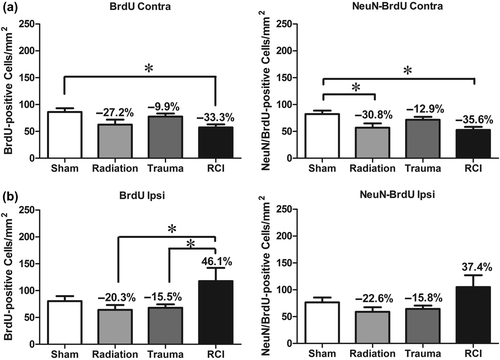Figures & data
Figure 1. Schematic diagram showing experimental design. Three-week-old and eight-week-old C57BL/6 mice received whole body irradiation with 4 Gy 137Cs. Four weeks later animals received either focal traumatic brain injury or sham injury. Two weeks later, animals were injected daily for 7 days with BrdU (100 mg/kg). Four weeks after BrdU injections, animals underwent Morris water maze testing for 5 days.

Figure 2. Cumulative distance to the target platform during visible and hidden training sessions. (a) During the visible platform training (day 1 and 2), all experimental groups swam similar distances to the platform. All groups showed daily improvements in their abilities to locate during the hidden platform training (day 3–5). However, trauma only (*p < 0.05; day 4, Holms) swam longer escape distances compared to sham mice. (b) All groups showed daily improvements in their abilities to locate during the hidden platform training (day 3–5). Radiation only (*p < 0.05; day 3–5, Holms) swam shorter escape distances compared to sham mice. Each datum point represents the mean of 8–10 mice; error bars are standard error of the mean (SEM).
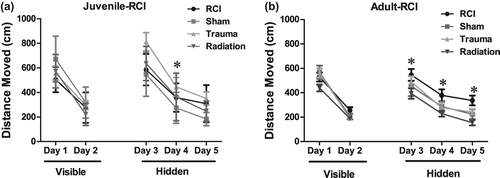
Figure 3. Spatial memory retention in mice during the Morris water maze probe trial following the first day of hidden platform training. (a) Juvenile-RCI mice showed an impairment of hippocampal-dependent spatial memory during the day 3 and day 4 probe trials. (b) All of the adult mice, showed memory retention in the water maze by spending most of their time in target quadrant which contained hidden platform. For all four treatments, when time spent in the target quadrant was compared to all other quadrants there was a significant (p < 0.05) preference. Each bar represents the mean of 8–10 mice; error bars are standard error of the mean (SEM).
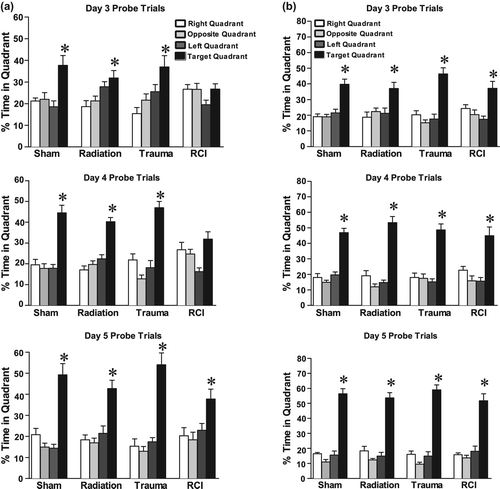
Figure 4. Total number of BrdU+ cells and BrdU+/NeuN+ cells per mm2 in the dentate subgranular zone of the Juvenile-RCI cohort. (a) In the contralateral hemisphere, there was a no significant group difference for BrdU+ cells (p = 0.242) or BrdU+/NeuN+ (p = 0.697). Percentage change compared with sham-treated animals. (b) In the ipsilateral hemisphere, there was a significant group difference for BrdU+ cells (p = 0.006) and BrdU+/NeuN+ (p = 0.004). RCI significantly increased the numbers of BrdU+ cells and BrdU+/NeuN+ compared to sham-treated and radiation only (p < 0.05). Percentage change compared with sham-treated animals. Each bar represents the mean of 9–10 mice; error bars are standard error of the mean (SEM).
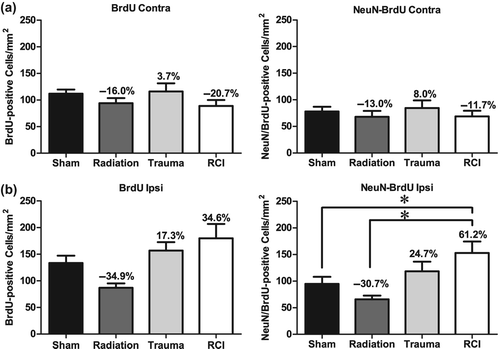
Figure 5. Total number of activated microglia (CD68+) and newly born microglia (BrdU+/CD68+) per mm2 in the dentate subgranular zone of the Juvenile-RCI cohort. (a) In the contralateral hemisphere, there was a no significant group difference in the total numbers of activated microglia (p = 0.606). There was a significant group difference for newly born microglia (p = 0.027). There were minor but insignificant increases in total numbers of activated microglia after radiation only and RCI. (b) In the ipsilateral hemisphere, there was a significant group difference for CD68+ cells (p = 0.01) and BrdU+/CD68+ (p = 0.009). RCI significantly increased in the number of activated microglia compared to sham-treated animals. Percentage change compared with sham-treated animals. Each bar represents the mean of 8–10 mice; error bars are standard error of the mean (SEM).
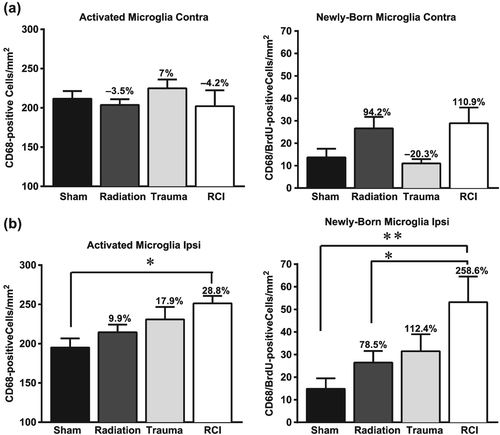
Figure 6. Total number of BrdU+ cells and BrdU+/NeuN+ cells in the dentate subgranular zone of the Adult-RCI cohort. (a) In the contralateral hemisphere, there was a significant group difference for BrdU+ cells (p = 0.029) and BrdU+/NeuN+ (p = 0.015). Radiation significantly decreased the numbers BrdU+ cells and BrdU+/NeuN+ neurons in radiation only and RCI mice (p < 0.05). Percentage change compared with sham-treated animals. (b) In the ipsilateral hemisphere, there was a significant group difference for BrdU+ cells (p = 0.027). RCI significantly increased the numbers of BrdU+ cells compared to radiation and trauma only (p < 0.05). In terms of newly born neurons, there was a trend toward a group difference (p = 0.0508). Percentage change compared with sham-treated animals. Each bar represents the mean of 9–10 mice; error bars are standard error of the mean (SEM).
